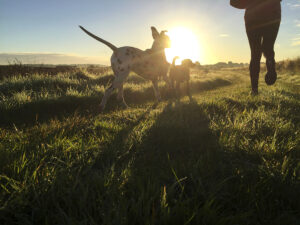
It’s important to know what can increase the risk of limb fractures in dogs so owners can be more mindful of their dog’s limitations to hopefully avoid this unfortunate situation.
As loving pet owners, we strive to provide our furry companions with a safe and nurturing environment. Unfortunately, accidents can still happen, and one injury that dogs may experience is a limb fracture. A limb fracture can be distressing for both the dog and their owner, but understanding the potential causes can help us prevent such incidents.
Traumatic Accidents
Trauma resulting from accidents is a leading cause of limb fractures in dogs. Dogs are naturally curious and energetic creatures, which can put them at risk of falls, collisions, or getting hit by a vehicle. Dogs who are allowed to roam freely without supervision are particularly vulnerable to these accidents. By ensuring a secure or fenced environment and keeping a watchful eye on our pets during outdoor activities, we can significantly reduce the chances of traumatic fractures.
Falls from Heights
Dogs, especially small breeds, are susceptible to fractures from falls from elevated surfaces. Jumping off furniture or beds can sometimes lead to limb fractures, particularly if the dog lands awkwardly. Dogs (and cats) are also known to fall out of windows, which often leads to limb fractures. As responsible pet owners, we should be cautious about allowing our dogs access to high places without proper supervision or assistance. Installing pet ramps or stairs can also help them safely navigate elevated areas.
Overexertion and High-Impact Activities
Engaging in vigorous activities, such as intense play sessions or strenuous exercise, can put excessive strain on a dog’s limbs, leading to fractures. Dogs with weakened bones, such as those with certain medical conditions or senior dogs, are more prone to these injuries. It is crucial to ensure that dogs engage in appropriate exercise and avoid activities that may exceed their physical limitations. Gradually increasing the intensity of exercise over time and providing sufficient rest periods can also prevent fractures caused by overexertion.
Osteoporosis and Bone Diseases
Certain medical conditions, including osteoporosis, bone cancer, or nutritional deficiencies, can weaken a dog’s bones, making them more susceptible to fractures. In these cases, fractures may occur even from minor incidents or normal activities. Regular veterinary check-ups and appropriate nutrition can help identify and manage these conditions, reducing the risk of fractures.
Age-Related Weakness
As dogs age, their bones naturally become more fragile, increasing the likelihood of fractures. Older dogs may develop conditions like osteoarthritis, which can compromise the integrity of their bones and joints. Providing a senior-friendly environment, including non-slip flooring and comfortable bedding, can help prevent falls and fractures. Additionally, regular veterinary check-ups and tailored exercise and nutrition plans can support the overall health and well-being of aging dogs.
Trust Maryland Veterinary Surgical Services With Your Companion’s Health
Your companion’s health is important, and the team at MVSS is ready to provide the best care possible for your furry family. We are dedicated to combining comprehensive exams and assessments with informative and honest discussions of your companion’s care. Once we have worked with you to decide on the best course of action for your dog, our professionals will use their surgical expertise to work towards the goal of giving your companion an active and pain-free life. We are proud to serve loyal companions in Catonsville and Baltimore. To learn more about our services, give us a call at 410-788-4088 or visit us online. For more information and tips for pet health, follow us on Facebook and Pinterest.
